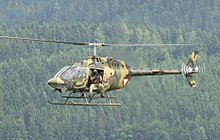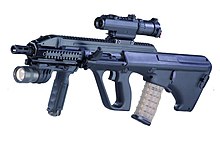Jagdkommando (Federal Army)
|
Jagdkommando |
|
|---|---|
| Lineup | May 4th 1963 |
| Country |
|
| Armed forces |
|
| Armed forces |
|
| Type | Special unit |
| Strength | 400 soldiers |
| Location | Wiener Neustadt (Lower Austria) |
| motto |
Numquam Retro (Never Back) |
| Awards | Bronze Star Medal Combat Distinguishing Device |
| commander | |
| Current commander | Philipp Ségur-Cabanac |
The Jagdkommando (JaKdo) is a special unit of the Austrian Armed Forces stationed in Wiener Neustadt . The tasks include the liberation of hostages abroad, the fight against terrorism , as well as building protection of the Austrian embassies and operations in war or crisis areas .
assignment
The Jagdkommando provides a presence unit of the special forces, which has quickly available elements for operations at home and abroad. Hunting commandos are usually deployed in small, unrecognized units and can perform the following tasks:
- Special education to obtain information for the management level;
- Command companies , such as the arrest of wanted persons, for example war criminals, the destruction of positions of heavy weapons, or the release of prisoners and hostages of persons held abroad.
- Military support , which includes the training of soldiers at the request of partners or friendly nations (also in a hostile environment).
Hunting commandos can also participate in:
- the protection of search and rescue operations
- Evacuations from crisis and war zones
- Counterterrorism
- The Jagdkommando supports conventional forces on international missions if the special hazard situation of a crisis area so requires
- Property security for Austrian institutions abroad.
In 2008, personal protection in the interests of the republic was transferred to the Military Patrol & Military Police Command .
organization
- Staff department
- Basic department
- Public Relations & Communication Department
- Base of operations
- 1. Task Group
- 2. Task Group
- 3. Task Group (mob)
- Teaching department
Calls

Operations by the Jagdkommando are fundamentally confidential ; operations that have become known to date have taken place in Chad , Mali , Afghanistan , Kosovo , Bosnia , Albania and Macedonia as well as in the context of various international observer missions .
In addition, soldiers were hunting commands to evacuations including in North Africa , the Turkey , in Peru and in the course of COVID-19 pandemic also involved in numerous European countries, are to tug fight inserted at the Austrian border and regularly assume in international exercises and I took part in training courses in various countries, including Norway, Denmark, Germany, Croatia, the USA and South American countries.
Mission in Chad
In December 2011, Profil magazine reported a battle between rebels and soldiers from the Jagdkommando, according to which Austrian soldiers killed several opponents near Guéréda.
Abseiling exercise from S-70 Blackhawk helicopters
Parachute jump from a C-130 Hercules of the Federal Army
Recruitment and training
Selection and qualification
Any Austrian citizen without a criminal record can apply to the Jagdkommando. The prerequisite for this is a completed basic military service with completed extended cadre training, the obligation as a regular soldier and a rating number (fitness level) of 7–9. In addition, the three-week selection process, which is composed as follows, is a prerequisite for admission to the Jagdkommando basic course:
- 8 km express march with 20 kg backpack over undulating terrain in a maximum of 60 minutes
- 30 m rope climbing in an inclined rope
- 300 m swimming in clothes (without shoes) in 11 minutes
- Jump into water from a height of 10 m on command without time delay
- Obstacle course under 5:10 minutes
- "AE testing" (there is a one-minute break between the exercises. ):
- at least 6 pull-ups in 60 seconds
- at least 48 squats in 120 seconds
- at least 31 pushups in 120 seconds
- at least 25 sit-ups in 120 seconds
- at least 19 squat jump jumps in 60 seconds
- 2400 m run in under 12 minutes
In addition, the following checks must be passed:
- Psychological and sensorimotor aptitude assessment
- A stress exercise to check performance and motivation
- Passing the full contact fight
However, passing the selection process does not guarantee admission to the Jagdkommando basic course. Instead, applicants are ranked according to their individual results and only the number of soldiers actually required is admitted to the course.
The Jagdkommando basic course itself has usually started in March every other year since 2009 and lasts 27 weeks, the training topics include advanced combat and weapons training, survival techniques, explosive training, military close combat , training in amphibious locomotion, parachute jump training ( military freefall ), alpine training (Summer and winter), house-to-house fighting as well as extended training courses in military medical service , orientation in the field and in telecommunications. After successfully completing the basic course, the soldier receives the hunting command badge with sword and parachute ("swing") and then either returns to his / her home unit or in future does his service in the hunting command and begins a multi-year special training there in one of the teaching groups.
Due to the physical and mental demands, only about 15% of applicants complete the course.
education
The main task of the Jagdkommando is to train Jagdkommando soldiers. In addition, the Jagdkommando trains specialists for other parts of the army. The special operations department is responsible for this. This department is divided into different teaching groups.
- Teaching group 1 : The heart of the Jagdkommando, commandos , special reconnaissance , specialized shooting and demolition as well as military close combat are taught here.
- Teaching group 2 : Parachute training. This group also leads courses for Airborne Forces of Jäger Battalion 25 , military academics and NCOs.
- Teaching group 3 : Combat swimmer and combat diver training. This teaching group also trains the pioneer divers of the army pioneer troops.
- Teaching group 4 : Environment training in jungle, desert and mountains. Survival training for special forces and aircraft crews of the armed forces is also taught here.
equipment
When it comes to information about equipment, the Jagdkommando is usually very reserved.
In addition to the equipment introduced into the armed forces, it uses a whole range of additional weapons and equipment that are not available to other units, such as the Steyr AUG A3 SF .
Furthermore, the Jagdkommando has equipment that is also used by other special forces, such as B. modern digital communication means, receivers for satellite navigation, night vision goggles and target devices of the latest generation as well as special equipment for parachutists, combat divers, bodyguards and operations in the mountains or in built-up areas. Among other things, a separate meal packaged in daily portions was introduced.
Uniform and badge

Originally, after completing the basic course, members of the Jagdkommando wore the wine-red beret customary for airborne units, since 2003 the color of the beret has been mud green.
After successfully completing the basic hunting command course, soldiers (even after leaving the unit) wear the command badge on the uniform over the left breast pocket and also wear the beret instead of the usual federal eagle.
Depending on the requirements of the mission, you wear your own uniform, half camouflage (opposing uniform parts or civilian clothing, is usually removed before the actual mission) or full camouflage (complete opposing uniform or civilian clothing also during the fight).
Others
- The motto of the Jagdkommando is numquam retro (never go back), which goes back to the Payer-Weyprecht expedition from 1872 to 1874, as well as numquam perimus (we never give up).
- In 2007, the Vienna Army History Museum dedicated a special exhibition to the Jagdkommando entitled "Your Buddy - The Hunting Command of the Austrian Armed Forces" .
Commanders of the Jagdkommando
- Colonel dG Ferdinand Foltin, Kdt Army Sports and Close Combat School (HSNS)
- Lieutenant Colonel Walter Persche, Kdt HSNS (1962)
- Colonel dG Robert Lang, Kdt HSNS (1967)
- Colonel Josef Wanetschek, Kdt HSNS (1983–1984)
- Lieutenant Colonel Manfred Foidl (1986–1995)
- Colonel dG Herbert Bauer (1995–1997)
- Colonel dG Wolfgang Wosolsobe (1997–1998)
- Colonel Reinhard Drazenowitsch (1998-2002)
- Colonel dG Reinhard Trischak (2003-2004)
- Colonel dG Siegfried Bognar (2004-2005)
- Colonel dG Heinz Assmann (2005)
- Lieutenant Colonel Rudolf Weissenbacher (2006)
- Colonel dG Harald Vodosek (2006-2007)
- Lieutenant Colonel Rudolf Weissenbacher (2007)
- Colonel dG Horst Hofer (2008)
- Colonel dG MMag. Philipp Ségur-Cabanac (2019)
Former Jagdkommando soldiers
- Bert Nussbaumer
- Christian Prosl
- Clemens Hellsberg
- Heinz Werner Schimanko
- Herbert Tumpel
- Rudi Gollner
literature
- Christoph Hatschek: Your Buddy. The Jagdkommando - Austria's elite soldiers on land, on water and in the air , in: Viribus Unitis. Annual report 2007 of the Heeresgeschichtliches Museum , Vienna 2008, ISBN 978-3-902551-06-1 , pp. 113–124.
- Markus Gollner: "Speed Action Surprise - The Hunting Command" Action Unlimited , 2009 ISBN 978-3-200-01385-8 .
- Wolfdieter Hufnagl: Jagdkommando - special units of the Austrian Armed Forces. Motorbuch-Verlag, Stuttgart 2000, ISBN 3-613-02079-3
- Sören Sünkler: Europe's elite and special units. Motorbuch-Verlag, Stuttgart 2008, ISBN 978-3-613-02853-1 , pp. 150–157.
- Reinhard Drazenowitsch: Hunting commandos deployed abroad - once, now and tomorrow . In: Christian Segur-Cabanac , Wolfgang Etschmann (ed.): 50 years of foreign missions of the Austrian Armed Forces (= writings on the history of the Austrian Armed Forces ). Published by the General Staff of the Federal Ministry for National Defense and Sport and the Museum of Military History , Vienna 2010, ISBN 978-3-9502653-1-6 , p. 359 ff.
See also
- Special Forces Command (Germany)
Web links
- Official Jagdkommando website of the Federal Army
- Detailed description and pictures on doppeladler.com
- Comradeship side of former JaKdo soldiers, rich in history
- The history of the Jagdkommando
- Bundesheer 1/3 - Jagdkommando and Blackhawk deployment scenarios
Individual evidence
- ↑ Terror: More money for the army's elite troops. Retrieved November 29, 2016 .
- ↑ missions. As a special task force, the Jagdkommando has successfully completed a large number of missions in the years of its existence. Retrieved February 15, 2019 .
- ↑ https://kurier.at/chronik/niederoesterreich/corona-krise-so-bringt-das-jagdkommando-landsfolk-nach-hause/400809866
- ↑ Gernot Bauer, Martin Staudinger: Desert Warriors. A RH report involuntarily sheds light on a state secret: Austrian soldiers killed rebels in Chad. December 2, 2011, accessed February 15, 2019 .
- ↑ The Jagdkommando basic training. The Jagdkommando offers you a fascinating and in any case exceptional professional challenge. Retrieved February 15, 2019 .
- ↑ The motto of the Jagdkommando. Archived from the original on December 10, 2008 ; Retrieved August 12, 2014 .
- ↑ General Ferdinand Foltin - "In memory of a fallen comrade, Rest in Peace" , website www.fjr6.net, accessed on June 25, 2016
- ↑ Heeressportmannschaft 1962 - 2007 , PDF document p. 24
- ↑ Head of the day: Colonel Heinz Assmann , website derstandard.at, accessed on June 25, 2016
- ↑ Afraid of Islam? (PDF) Retrieved August 26, 2014 .
- ↑ a b c d Die Presse : Clemens Hellsberg was also a wild dog , May 25, 2007








